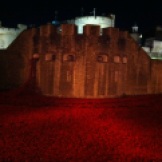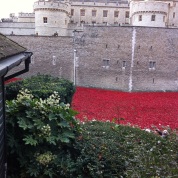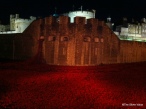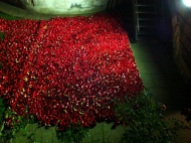The extent to which the Irish diaspora have left indelible marks in many corners of the world, yet are relatively unknown in their homeland never ceases to amaze me. One of the most memorable of these is County Tipperary man Martin O ‘Meara, a veteran of World War One, whose memory lives on in the parts of Western Australia where he lived and died.

A bright-eyed Martin O’ Meara, date unknown (Australian War Memorial, Public Domain
Martin inscribed his name into the annals of history for his actions during the Great War, service which earned him the highest decoration for gallantry. But it was also a conflict that destroyed him, ultimately consigning him to long years of mental anguish and institutionalisation. This is his story.

Irish tricolour far from home
On March 17th 2014, at the Western Australian State Memorial Park in Perth, an Irish tricolor fluttered in the breeze. A member of the Irish Government was coming to lay a wreath at one of the tablets surrounding the Flame of Remembrance. The entourage was led by Mr Alan Kelly T.D. (now Minister of Environment, Community & Local Government) then Minister of State at the Department of Transport, Tourism and Sport, and Mr Marty Kavanagh, Honorary Consul of Ireland in Western Australia. In a very simple and moving ceremony Mr Kelly honoured his fellow Tipperary man at the plaque inscribed Pte Martin O’MEARA VC, 16th Australian Infantry Battalion AIF, 9 September 1916.
So who was Martin O Meara? Since that ceremony I have made it my mission to find out, traveling to some of the sites associated with him and spending long hours exploring many of the historical documents associated with his life.

Martin O Meara in 1916
Image WikimediaCommons
Martin O’Meara (Meara) was born in County Tipperary, Ireland in November 1885, one of 11 children of Michael and Margaret. In the 1901 census we find 15-year-old Martin living with his father and mother, three older brothers and two older sisters in the townland of Lissernane. By the time of the 1911 census, his mother has been widowed and she is living in the same house with one son and one daughter. We cannot be sure where Martin was at this time, but a Martin O’Meara born in Tipperary and of the correct age is recorded working in the timber industry in Kilkenny as per this 1911 Census entry for Skeard. Could this be Martin, a wood worker and boarder in the house of a mill worker? We do know that he made his way to Liverpool about 1911, and onwards to Australia In 1914. He eventually settled in the vast timber forests around Bowlling Pool, Western Australia some 30 plus miles from the town of Collie. It was here that he found work as a sleeper-cutter, servicing the rapidly expanding railway system of Western Australia.

Rathcabbin – near Martin’s birthplace

Lush pasture near Rathcabbin
On August 19, 1915 Martin O’Meara enlisted in the Army at Blackboy Hill in Western Australia. His Attestation Papers show that he was born at Rathcabbin, that he was 29 years and 9 months old, 5 feet 7 inches in height, weighed 140 pounds and had a dark complexion, brown eyes and brown hair. He nominated his sister Alice as his next of kin. As a member of the Australian Expeditionary Force, he arrived at Marseilles, France, on June 1, 1916. Just a matter of weeks later the Tipperary man was in the middle of the Somme offensive, possibly acting as a stretcher bearer in a fierce assault on the Germans at Mouquet Farm, near Pozières. The fighting here was bitter with the Anzac forces suffering heavy losses. It was here, between August 9 and 12 that Martin O’ Meara distinguished himself with acts of bravery that earned him the Victoria Cross, the highest award for gallantry in the face of the enemy. The citation read: during 4 days of very heavy fighting, he repeatedly went out and brought in wounded officers and men from No Man’s Land under intense Artillery and Machine Gun fire. He also volunteered and carried up ammunition and bombs through a heavy barrage to a portion of the trenches which was being heavily shelled at the time. He showed throughout an utter contempt of danger and undoubtedly saved many lives.

September 1916. 3970 Private (Pte) Martin O’Meara being congratulated by fellow hospital patients, at Wandsworth, all wearing ‘hospital blues’, following the announcement of his Victoria Cross award. (Image Australian War Memorial, Public Domain)

Martin O’Meara after Poziers, meeting another V C recipient, Albert Jacka. Image Wikimedia Commons
Martin won high praise for his actions, with Lieutenant W.J. Lynas describing him as the “most fearless and gallant soldier I have ever seen”, while Lieutenant F. Wadge stated in dispatches that he rescued more than 20 soldiers during a barrage of high explosives and machine gun fire that was “intense beyond description.” On yet another occasion, he ventured into no-man’s land under heavy artillery and machine gun fire to retrieve six more of his comrades. The courageous Martin did not stop there, as Lieutenant Colonel E.A.D. Brockman, Commanding Officer of the 16th Battalion, said, he “continued to venture out into no-man’s land after his company had been relieved, delivering first aid to the wounded, digging out soldiers who had been buried by high explosive shells, and carrying the wounded back to the dressing station.” Martin O’Meara was presented with his Victoria Cross by King George V in July 1917

Martin O Meara’s Victoria Cross
Private O’Meara suffered gun shot wounds to the abdomen during this action and was evacuated to England and admitted to Wandsworth Hospital on August 19. He rejoined the 16th Battalion on December 22. He was wounded twice afterwards, but rejoined his unit each time.

Outdoor photograph of Martin O’Meara, date unknown. (Australian War Memorial, Public Domain)
On August 31, 1918 he was sent to the UK for return to Australia, arriving back in Fremantle on November 6 1918. Sadly that was not the end of the war for Martin. The quiet, courageous man from rural Tipperary who had survived the hell of battle did not live happily ever after. He had already embarked on another journey into hell, a journey that was to last for the rest of his life. Martin was discharged from the army on November 30, 1918. Within days it was reported that he was “delusional” and he was transferred to Stromness Mental facility directly from quarantine, and from there to Claremont Mental Hospital three months later. The sights, sounds and the horrors of war on the Western Front had driven the quiet Tipperary man mad.
We know a little about Martin O’Meara’s personality as newspapers responding to the award of his V.C. sought accounts from people in Australia who knew him before enlisting. One friend described him as a strong but gentle teetotaller, while another remembered him as reserved but with a very genial character. A former employer reported that he was “generous to a fault” and willing to perform any task asked of him. He was a member of the Hibernian Australasian Catholic Benefit Society. A few of his letters back to Australia have been published and they are evidence that he was a caring, compassionate, humble man, who made reference to God and his deeply held beliefs.
By contrast, his military records contain many shocking details of his post war condition. In December 1918 he was described as “extremely homicidal and suicidal and requires to be kept in restraint” with no hope of his recovery. The Inspector General of the Insane furnished a report of Martin’s condition during the 17 years he was in the Asylum. He was initially obstinate and difficult, restless, sometimes violent, noisy during the night, suffered from hallucinations and attacked the attendants. By 1923 he “showed loss of control” and frequently needed sedation. In 1925 he was again described as obstinate, difficult to manage, sometimes taking 3 or 4 attendants to put him to bed and in 1927 he is recorded as pacing the floor and rushing wildly to and fro cursing imaginary persecutors. By 1934, it was reported that he was “disconnected in his conversation” and was shameless, sometimes exposing himself and using abusive language. In 1926 he had been transferred to Lemnos Hospital, but because of his ”violent propensities”, he was sent back to Claremont Mental Hospital in November 1935. Six weeks later, on December 19, 1935, he collapsed following a period of continued excitement and died the following day from Pulmonary Oedema, chronic mania and exhaustion. His death was recorded as “due to war service.” Martin O’Meara V.C. received a military funeral at Karrakatta Cemetery in Perth, with representatives of the military and the state in attendance as well as other V.C. winners. The funeral cost to the state was 16 Pounds and 13 Shillings.

Grave of Martin O’Meara V.C.

Martin O’Meara V.C. Finally at rest.
Shell shock was a relatively new phenomenon,that affected thousands of soldiers. In the war’s early days it was not understood and sometimes dismissed as mere hysteria, especially in enlisted men. Nervous disorders were frequently viewed as disciplinary matters, with sufferers often accused of being cowards or malingering. It is not clear when Martin O’Meara was first affected by it as it is not referred to in any of the military records, but it is unlikely that it first manifested itself on his return to Australia. In any event, the psychological trauma he suffered caused his war to continue for 17 years after the last shots of war were fired. We do not know if he had any friends in the institutions for the insane or whether he had any visitors who cared about him. Was he forgotten for those long years of anguish? His sister Alice, who was in receipt of a fortnightly pension of 25 shillings based on Martin’s service, asked for and received accounts of him from time to time and there was also an enquiry made about him on behalf of one of his brothers.
Martin continued to make headlines following his death as a dispute arose about the validity of a new will he made when recovering from a wound in hospital in Bath, England, in 1917. After winning his V.C. in 1916, the people of Tipperary had a collection in his honour and he was presented with a gold watch. As a serving soldier he was unable to accept the remaining balance of the money collected, but in his will he bequeathed it for the restoration of an Old Abbey in Lorrha village, while his Australian Estate of over two thousand pounds was left for the education of his nephews in Ireland. His Victoria Cross was to be given to a friend (coincidentally from Kilkenny, some 2 miles from Skeard, as noted in the 1911 Census above ) provided she went to live in Western Australia for a period of 12 months, otherwise it was to be retained in Western Australia. However, the money in Ireland was insufficient to restore the ruined Lorrha Abbey and the local priest succeeded in having the court agree that the monies be used instead to repair confessionals in the Catholic Church with the balance being used for Redwood National School. Martin O’Meara’s contribution to the local parish is marked by a small brass plaque in the Parish Church in Lorrha, Co Tipperary, while further up the street there is a memorial to Martin, unveiled in recent years by proud parishioners, to commemorate the local boy who became a hero in Australia.

Bronze plaque in Lorrha Parish Church

This monument was erected in 2013 in the village of Lorrha Co Tipperary
His Victoria Cross now resides in the Military Museum of Western Australia who would dearly love to have all of Martin’s medals in their collection. Martin’s British War Medal and Victory Medal were delivered to the family on June 24, 1924, with the receipt noting that Martin was then “an inmate of the Claremont Hospital.”

Martin O’Meara memorial in the Army Museum of Western Australia
Martin O’Meara continues to attract headlines in Australia, almost 100 years after the end of World War 1. In the little coal mining town of Collie, near where Martin worked in the Jarrah forests as a sleeper hewer, there is another plaque in his memory, and here Ireland’s Ambassador to Australia laid a wreath in his honour after a lovely Irish themed reception at the town hall. The ceremony was followed by a production in the local school hall of a play dedicated to Martin O’Meara, Under any Old Gum Tree, written and directed by Noel O’Neil.
Martin O’Meara’s life long torment epitomizes the Pity of War. His name and his story are centre stage within the Irish communities in Perth and in Collie, who remember his courage and valour with great pride, even though he had only lived in the area for a relatively short time prior to enlistment. The people of his homeland beyond his own Tipperary locality in Ireland deserve to know more about him and remember him too.

Martin O’Meara’s Victoria Cross. Author with Mr Graham McEwan, Chairman, Army Museum of Western Australia
*I am deeply grateful to Mr. Graham McEwan, Chairman, Army Museum of Western Australia for permitting me to see and photograph Martin O’Meara’s Victoria Cross, which is not on public display.
*I am indebted to Leith Landauer of Perth, Western Australia, a passionate stalwart of the cause of Martin O’Meara,V.C., my tour guide with an encyclopaedic knowledge of WA heritage, and my friend.
*Following publication of this post, Mr Fred Rea of ”The Australian Irish Scene” shared the following information:
There is a website devoted to Martin O’Meara at
Here is a link to the British Pathe newsreel footage that we believe shows O’Meara getting presented with the VC medal by King George V at Buckingham Palace in 1917. O’Meara starts at about the 22 second mark….
Thank you, Fred!
References:
National Archives of Australia Records as follows:
NAA: PP13/1, C5474
NAA: B2455, O’Meara M
NAA: PP645/1, Martin O’Meara V.C
O’Meara, P., & Devenish, S. (2010). Sir Neville Howse (VC), Private John Simpson Kirkpatrick and Private Martin O’Meara (VC) and
their contributions to Australian military medicine. Australasian Journal of Paramedicine, 8(1).
Shell Shock and Mental Trauma in World War 1, Dr Fiona Reid, Open University at FutureLearn.





























































 Just a year ago I visited the art installation at the Tower of London which commemorated the centenary of the beginning of the First World War. The installation Blood Swept Lands and Seas of Red was made of ceramic poppies, one for each of the 888,246 men who perished in the British Army at that time. Tens of thousands of those who died were Irishmen.
Just a year ago I visited the art installation at the Tower of London which commemorated the centenary of the beginning of the First World War. The installation Blood Swept Lands and Seas of Red was made of ceramic poppies, one for each of the 888,246 men who perished in the British Army at that time. Tens of thousands of those who died were Irishmen.














































































